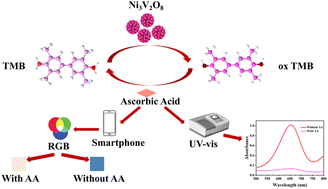Ni3V2O8 nanoflower mimetic enzyme constructs a dual-signal system for ascorbic acid detection
Abstract
Ascorbic acid is a nutritional small molecule essential to human life activities and health, playing a vital role in many physiological processes. Fresh fruits and beverages can provide abundant AA to maintain human metabolic balance. Therefore, it is of great significance to develop a nanomaterial with superior nanozyme activity for rapid and convenient detection of ascorbic acid (AA) in fruits and beverages. Herein, a dual-signal sensing platform based on UV-vis absorption and test strip chromaticity for the quantitative determination of AA is presented. The sensing platform is based on the horseradish peroxidase-like activity of Ni3V2O8 nanoflowers, which catalyzes the oxidation of 3,3′,5,5′-tetramethylbenzidine (TMB) by hydrogen peroxide to the blue oxide TMB (ox TMB). The ox TMB produced by the oxidation has a characteristic absorption peak at 650 nm. In the presence of AA, the blue ox TMB is reduced to colorless TMB, and the quantitative detection of AA can be achieved by detecting the decrease in intensity of the absorption peak by UV-Vis spectrophotometry. Under the optimal experimental conditions, the sensing platform exhibited excellent sensitivity and selectivity. A wide linear range of 0.1 μM to 40 μM with a detection limit of 0.032 μM was obtained. The linear equation is ΔA = 0.02513c + 0.1164 with a correlation coefficient of 0.9979. It showed excellent properties in the detection of real samples of fruit juices and beverages, meanwhile, a method for the rapid detection of AA based on chromaticity change of test strips was constructed with high sensitivity and convenience. The linearity range for the ascorbic acid was 1–50 μM with LOD of 0.42 μM. The developed sensing platform has the capability to quickly and accurately detect ascorbic acid (AA) in fresh fruits and beverages. This proposed method offers a new and promising approach for the rapid and cost-effective detection of ascorbic acid, which has a wide range of potential applications.



 Please wait while we load your content...
Please wait while we load your content...